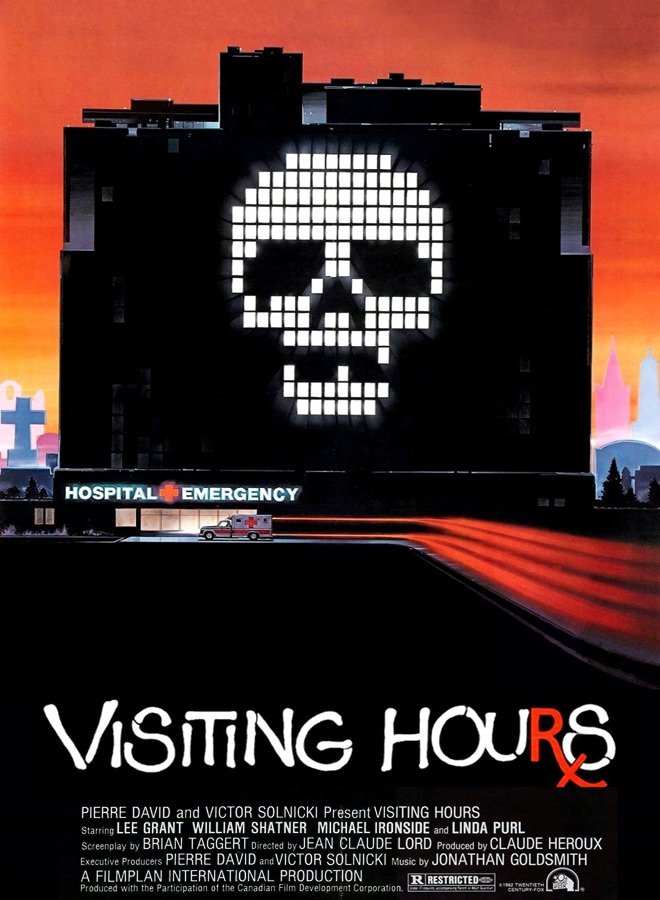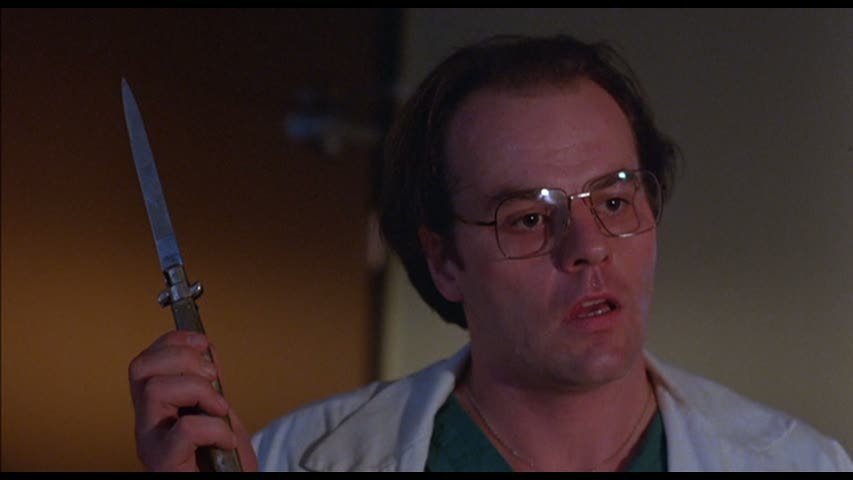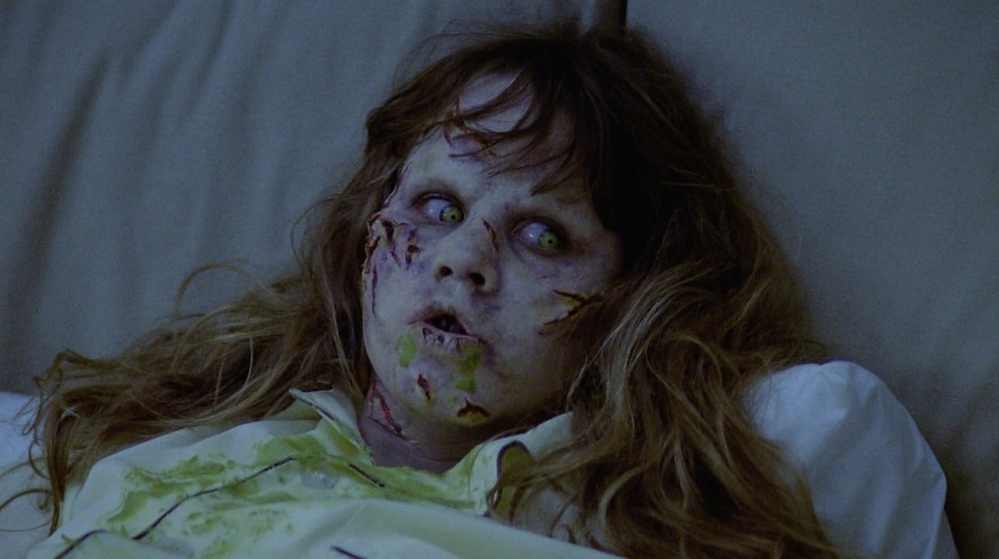RETRO REVIEW: 'VISITING HOURS (1982)'
When Jean-Claude Lord’s Canadian slasher, VISITING HOURS, came out forty years ago, the slasher craze was beginning its zenith in the cultural lexicon, with more than 30 other slasher films releasing that same year, among them, FRIDAY THE 13TH PART III, THE NEW YORK RIPPER, and SLUMBER PARTY MASSACRE. When the film was released, it was met with overwhelmingly negative review from critics, who commented primarily on the film’s portrayal of violence against women, including Tom Shales of The Washington Post who wrote: “You’re not just sorry you came to a movie like this; you feel saddened and troubled that it even exists, that someone saw a few more quick bucks in such a tired, ritualized, and malicious formula.”
Listen, I’m not here to disprove a statement about a film that has a 14% Rotten Tomatoes rating, even though I feel like that is kind of lowballing this genuinely creepy and terrifying slasher. There is a lot about this film that isn’t great and is exploitative, but to dismiss it as just another “tired, ritualized” slasher is also missing so much more about the film and what it tells us about white male rage and violence against women even today.
Michael Ironside in Jean-Claude Lord’s VISITING HOURS.
PLOT:
VISITING HOURS (also known as Get Well Soon and The Fright) is a 1982 slasher film directed by Jean-Claude Lord and starring Michael Ironside, Lee Grant, Linda Purl, William Shatner and Lenore Zann, and focuses on a feminist journalist who becomes the target of a serial killer who follows her to the hospital after attacking her in her home.
Linda Purl in VISITING HOURS.
KILLS:
We first meet our protagonist, Deborah (played by the solid Lee Grant) who is debating a lawyer defending a man on her television newscast who nearly killed his wife during a domestic violence incident. The woman in question killed the abusive husband and is now up on a murder charge which Deborah and many others, feel is unjust. The lawyer (who yes, is a man) disagrees with her, giving some misogynistic bullshit about it being her fault, and Deborah isn’t having it. After the broadcast, Deborah vents to her producer (played by a rather sedate William Shatner), who chastises her for going so hard against her guest, threatening not to air it. She responds, shaking in fury, “I’m so angry,” a seemingly simple statement, but one that really hit me hard. Remember, the year this movie came out, the Equal Rights Amendment fell three states short of ratification (despite former Presidents Jimmy Carter and Gerald Ford issuing a joint statement urging ratification of the amendment), and the average employed woman with children did 30 hours of housework in addition to her paid job. Women were angry, and for good reason.
However, women were also making progress during that time, especially on the political landscape: Sandra Day O’Connor was sworn in by President Ronald Reagan as the first woman to serve in the U.S. Supreme Court the year before, and in 1980, Paula Hawkins of Florida became the first woman to be elected to the U.S. Senate without following her husband or father in the job. While women were angry at their lack of progress, so were men at the strides women were making, as support for feminist causes grew in strength from both men and women alike.
Bear with me, I’m AM getting to the stabby-stabby stuff here, I promise.
We soon see that someone is stalking Deborah at the station, and in a scene reminiscent of the opening of SCREAM (1996), we follow Deborah home as she gets ready for bed, opening doors, and turning on lights, every moment ratcheting up the tension. When the killer (played by a fantastically savage Michael Ironside) finally bursts out of a door in her bedroom, naked and slashing at her, it is so startling and unexpected, that it sets the tone for the rest of the film. What follows is a great cat-and-mouse chase scene through her house that leaves Deborah injured and the killer on the run.
Deborah is left to recoup at a local hospital while we get more insight into our killer, named Colt, who is racist and misogynistic, proudly displaying his vitriolic letters to newspapers and television outlets expounding the dangers of women’s and civil rights in frames around his apartment, as well as polaroids of women he has killed. He is the epitome of ignorant, white male rage.
That rage takes him to the hospital that Deborah is recovering at, determined to finish the job, posing as a florist to get into what he thinks is her room. When he goes to kill her in her bed, he realizes it’s not her. Undeterred, he calmly sits on her bed, disabling her oxygen tube as he takes polaroids of her, her eyes wide with terror, looking at him as she slowly dies. It is an absolutely chilling scene in a film filled with some disturbing, albeit not terribly gory kills.
Michael Ironside plays a sadistic killer out to eliminate a feminist reporter.
VISUALS/SFX:
I’ll be honest. This section of the review is going to be a little light on the ole’ word count, mainly because VISITING HOURS in terms of visuals, effects, cinematography, is pretty unremarkable. I could point to a hundred other slasher films that look like this film, which isn’t necessarily a bad thing, because, even though it suffers from pacing issues, it is competently directed. However, you can tell by this time the slasher film market was really starting to experience the growing pains of oversaturation. The only thing I will note, mostly because it's probably one of the more disturbing visuals of the film, is when Colt, near the end of the film, realizes he’s being closed in on and is desperate to get back into that hospital to finish off Deborah. He comes home, downs a bunch of pills with a bottle of beer, wraps a belt around his arm like a tourniquet, and proceeds to smash his arm down on the empty bottle, smashing it and leaving his arm bloody and full of broken glass. It’s an unsettling scene, and it reminds the audience of how single-minded Colt is in his rage against this woman, whose only crime against him was speaking out in the defense of the rights of women.
Linda Purl and Lee Grant in VISITING HOURS.
PERFORMANCES:
Even though the visuals are lackluster, the performances more than compensate, in particular, Michael Ironside who, natch, completely steals the show. There is a reason this guy is still playing bad guys 44 years into his acting career. Because he always fucking hits it out of the park. He plays Colt as a sadistic, cold-blooded, psychopath, who will do anything to preserve his sexist, bigotied, insulated little world of hate. At one point in the film, he brings home a young woman, who notices the antipathy-filled letters on his walls. Reading them, she muses out loud: “God, you blast them all: blacks, Jews, Mexicans...you want the whole goddamn world to yourself?”, to which Colt replies simply: “Yeah, I’d like that.” Though we get insights into Colt’s abusive childhood at the hands of his father, Ironside does not attempt to wrought any true sympathy for the character from the audience. There is no excuse for Colt’s deep-seated sexism and racism, which is why the payoff at the end is so satisfying for us.
But in order for Ironside’s performance to really work, we need to have strong female characters for us to relate and root for, and both Lee Grant and Linda Purl (who plays Nurse Sheila) provide a great counterbalance for that, both women providing two different glimpses of the feminist movement at that time. Lee Grant as Deborah is a woman in her prime, the epitome of the “privileged” feminist - famous, wealthy, childless, and married to her career. She is a perfect target for Colt because she is everything he hates: an intelligent, successful woman with a platform to speak her mind. Deborah’s encounter with Colt leaves her shaken to the core, unable to grasp why someone would want to kill her over her voicing her opinion (a little naïve of her, but hey). Enter Linda Purl’s Nurse Sheila, who is overseeing Deborah’s care at the hospital. Sheila is a blue-collar, working, single mom, who bonds with Deborah and is a supporter of her feminist beliefs. The women form a fast friendship, which becomes threatened when Colt realizes she is caring for Deborah and decides to target Shelia, but it is ultimately the respect and bond between the two women that ends up being his undoing.
William Shatner in VISITING HOURS.
OVERALL IMPRESSIONS:
What separates VISITING HOURS from other tiddy-baring, slice-em-ups from the early 80’s is not that the preyed-upon women get their revenge, it’s that they lift each other up to survive an extremely tragic situation. That is a pathetically rare situation, even in today’s films. I don’t know about you other ladies (and hopefully, there are one or two of you reading this), but I’m over the tired trope of an obnoxious, self-centered woman double-crossing another woman just to get out of a life-and-death situation. Hell, I’m tired of it on social media and our culture in general. Women negging other women, pulling them down because of stupid, sexist stereotypes. It’s bullshit, and needs to end. Women supporting other women, encouraging them, is an absolutely beautiful thing, and needs to be celebrated and cultivated now more than ever.
This is a film that does not gloss over the feminist/misogynistic overtones of the 80’s slasher, and in fact, makes the issue front and center, while still sometimes falling victim to the very pitfalls it seeks to sidestep. Throughout the film, we are reminded of the prevalent, yet subtle sexism that creeps insidiously into our everyday lives: a soundbite from a television with a man saying a woman should look her best at all times, a woman getting labeled as “emotional” where a man would be seen as hard-hitting and a go-getter. It is a film that, as a woman, I am reminded yet again of how differently I have to navigate through life because of my gender, and yes, though The Washington Post’s Tom Shales seemed more “saddened and troubled” that yet another “tired, ritualized, and malicious” slasher had been born into existence, I would argue that perhaps Tom had gotten off the freeway before his exit, because as a woman, what is truly tired, ritualized, and malicious for me is misogyny itself.
A killer with a penchant for targeting women stalks a reporter in VISITING HOURS.
THE GORY DETAILS:
This was the first of the UK's infamous 'Video Nasty' films to be aired on television. The ITV network aired the film uncut in 1989 and subsequently the network received a fine from the Broadcasting Standards Council.
William Shatner really wanted to play the role of Colt Hawker. He nearly got the part but was told that before it could be offered to him, there was one more actor left to audition. The actor was Michael Ironside.
The limp Michael Ironside sports at the end of the movie was real. He broke his ankle on the first day of filming.
MY RATING: 6.5/10
WHERE TO WATCH:
YouTube
Stay up to date with “The Dark Side Of Pop Culture” by following MacabreDaily on Instagram, Facebook, and Twitter.


















